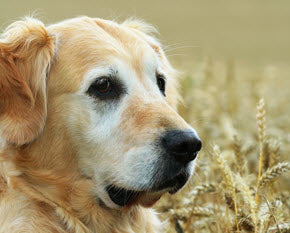
Millions of us are seeing the benefits of a grain-free, gluten-free diet, but what about our dogs? Would they also benefit from a grain-free diet? Let’s take a closer look … starting back in the early days of hunting and gathering their food.
It’s hard to imagine the days when they had to fend for themselves, but before our dogs came indoors and became part of the family, canines would hunt and capture raw, protein-rich meals. They were meat-eating carnivores and proud of it!
Flash forward … what happened? Around the time of World War II, mass-produced dog kibble came on the market loaded with inexpensive fillers like corn, wheat and barley to add bulk and keep costs down. While the quality of dog kibble has improved greatly in recent years, many commercial dog foods still list corn or wheat as a main ingredient.
Doggie Digestion 101
While dogs have evolved from wild animals to celebrity status, their digestive systems are the same as in primitive years. They have little ability to break down and metabolize complex carbohydrates and cereal grains. These difficult-to-digest fibers and grains remain undigested, relying on fermentation to break them down, which can explain the deadly gaseous smells you experience from time to time.
Over time, this process can damage the lining of the digestive system which can result in inflammatory bowel disorders, food sensitivities, food allergies, leaky gut and obesity. If your dog is experiencing any of these signs, talk to your veterinarian. Your dog may have a food allergy:
- Excessive flatulence (passing gas)
- Loose stool or diarrhea
- Rash and skin irritations
- Chronic licking, chewing or biting to relieve itching
- Vomiting
- Frequent ear infections
What’s in Your Dog’s Food?
If your dog is not experiencing any of these signs and seems perfectly happy and healthy, you may not need to make any dietary changes. If you’re thinking of doing so, check in with your vet before any major food changes.
In the meantime, check out the ingredient list on your dog’s food – is corn, wheat or soy listed as one of the first ingredients? If so, you may want to change to a formula where protein is one of the main ingredients. Introduce the new food slowly so your dog’s digestive system can adjust. Keep an eye on your dog’s elimination to make sure they’re not constipated or having diarrhea. Contact your vet if you have any cause for concern.
Benefits of Grain-Free Dog Food
Many vets today are recommending diets low in carbohydrates and grains. Dogster has a great article about what to look for, saying “an average dog should have a diet that is 50% vegetable, 40% meat and 10% grain.”
Grain-free dog foods, especially the moist and freeze-dried grain-free dog foods, contain more protein and animal fats and fewer carbohydrates. Benefits include:
- More easily digested
- Keeps dogs fuller longer
- May help reduce food allergy signs
- More energy
- Fewer and smaller stools
- Healthier skin and shinier coat
- Less shedding
- Better smelling breath
- Reduced flatulence
Be sure to keep an eye on the carbohydrate content of the grain-free diet you are considering. Some might think a grain-free diet is low in carbohydrates, but this may not be the case. Some vegetables such as potatoes, sweet potatoes, green peas and tapioca are often used to replace the grains. While you want your dog to get more vegetables, be on the lookout for these high-carb vegetables.
If you have a puppy, be aware that a diet high in protein can be damaging to their kidneys. Grain-free diets are generally recommended for adult dogs. Consult with your vet for an appropriate diet for your puppy.
This blog is brought to you by Under the Weather®, provider of bland diet products for dogs. These bland diet products offer a quick and convenient solution when dogs experience digestive issues such as vomiting or diarrhea. Ready to go in minutes – just add boiling water to rehydrate.
Our bland diet recipes are made with 100% human-grade meats – no meat by-products, antibiotic free and no hormones added! They are gluten free and have no chemicals or dyes. Sourced and manufactured in the U.S.A.
View Our Products
Visit Our Blog Library




